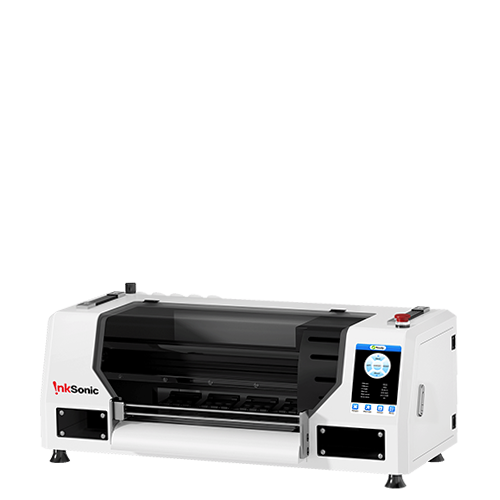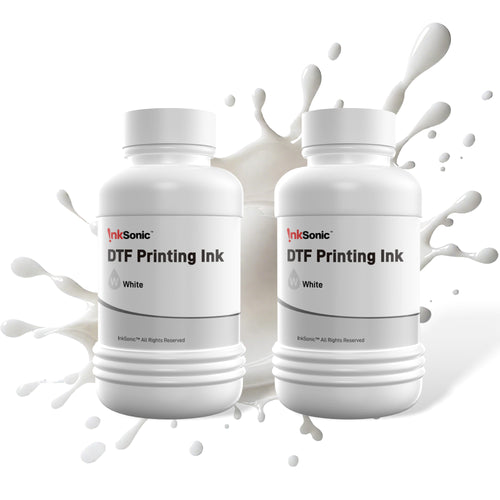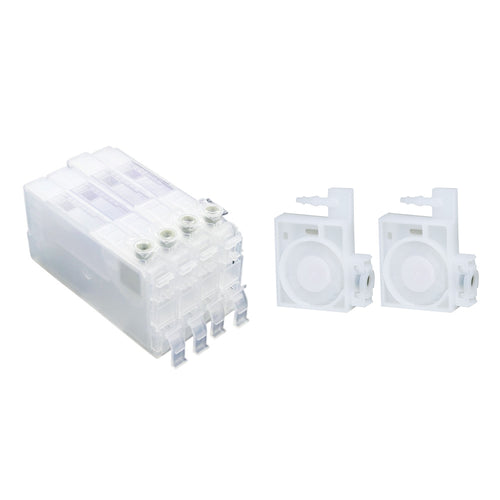UV DTF printing is no doubt one of the most popular and profitable technology in printing industry. It offers excellent versatility, vibrant colors, and durable effects. However, as with any emerging printing process, questions arise. Here are the 15 most commonly asked questions!
1. What is the difference between DTF and UV DTF?
DTF and UV DTF may seem to be alike but are not. Normal DTF involves printing designs, primarily for fabrics, using heat.
On the other hand, uses UV-cured adhesive and a laminate film to stick designs onto hard surfaces like glass, metal, and plastic—no heat is required. The biggest advantages of it includes:

- No heat press required – Works on non-fabric materials without the risk of heat damage.
Stronger adhesion – More durable than water or heat transfer methods.
Vibrant colors with texture – UV ink creates a slight 3D effect, making designs pop.
2. Is It Easy for Beginners? What's the Cost of Equipment?
UV Direct-to-Film printing is extremely easy to learn, even if you're a total beginner. Just print, laminate, peel, and apply—no heat pressing, no tricky setup.
Ease of Use
If you're able to operate a standard printer, you'll be able to manage UV DTF. The procedure is simple, so you can concentrate on designing rather than fighting with technology.
Equipment Cost
A printer setup costs between $4,000 and $20,000, depending on the brand and functionality. While this is a cost, it's still much lower than conventional UV printing setups.
Operation & Maintenance
Routine operation is straightforward enough, but occasional maintenance—like cleaning heads and monitoring ink levels—keeps all things running properly. For anything more serious, having a tech support number or service agreement will spare you aggravation and time.
3. What material or surface can decal or sticker be applied to?
Examples of materials where the UV DTF decals and stickers can be used include but are not limited to:
- Plastic
Metal
Glass
Ceramic
Wood
Coated paper and cardboard surfaces.

4. How long do decals, and cup wrap stickers last?
UV DTF decals and cup wrap stickers are made to be extremely durable, and with a proper application, can endure for many years—commonly 3-5 years indoors and up to 1-2 years outdoors, depending on exposure to elements like sunlight, moisture, and wear.
5. Are decals/stickers Waterproof?
In most instances, UV Direct-to-Film decals/stickers are waterproof to the point of using them even on mugs, bottles, and outdoor exposures. UV Printing process helps it get resistant to water, this ensure long-term durability.
6. What is a UV DTF gang sheet?
A UV Direct-to-Film gang sheet is a design that holds several images or stickers on one sheet, allowing maximum utilization of space and efficiency in printing. It is an economical method of printing many designs at one time, particularly for orders placed by customers.

7. What are UV DTF cup wraps?
UV Direct-to-Film cup wraps involve customized decals, which one can use as a wrap onto a cup or tumbler. These wraps are printed by using technology, which will allow full vibrant, durable designs that cover the whole circumference of the cup. A UV process ensures that the design is long-lasting and will not fade.

8. What UV DTF Products Make the Most Money?
The most profitable UV Direct-to-Film products are high-demand, customizable items like:
- Custom tumblers and glassware (great for small businesses and gifts)
Branded promotional products (logos on keychains, pens, and metal signs)
Acrylic signage (wedding decor, business nameplates, home decor)
Phone cases and accessories (trendy and always in demand)

In addition to these, you can also sell stickers directly, which are perfect for providing decorative materials for holiday events or store promotions. This is another excellent option to boost your revenue!
9. Are There Hidden Costs in UV Direct-to-Film Printing?
Other than the UV Direct-to-Film printer itself, here are some supplies costs you have to take note of:
- Ink : Good UV quality ink is essential for long-lasting and vivid prints.
Transfer Film (A film and B film) : A good transfer film can make a lot of difference in adhesion and the overall quality of your print.
Laminating Rolls or extra lamination machine if needed : These are highly important in the lamination of prints to ensure they last.
Varnish : Varnish is often applied to add extra protection to make prints more resistant to wear and tear.
Other minor expenses include electricity that the printer will use, cleaning materials, and the few unavoidable accidents or misprints that lead to the wastage of materials. Knowing these likely day-to-day expenses well in advance can make all the difference when planning for your Budget.
10. How Do You Transfer Prints?
Transferring UV Direct-to-Film is simple, as shown in the picture. You can then transfer:

11. How to store UV ink and AB transfer film
Storage Item |
Storage Method |
- Store in a cool, dry place with temperatures between 10°C and 24°C. |
|
- Ensure the container is tightly sealed to prevent air exposure. | |
- Do not freeze, as it can alter the ink's chemical composition. | |
- Check the expiration date before use to avoid using expired ink. | |
- Store in a dry, cool place to avoid moisture. |
|
- Keep away from sunlight to prevent fading or damage. | |
- Keep the protective packaging sealed to prevent dust contamination. |
12. How to Get Perfect Color Accuracy with UV Direct-to-Film?
To achieve professional-quality prints, consider:
- Color Management: Use ICC profiles tailored to your printer and ink.
Proper Curing: UV lamps must cure ink correctly to maintain vibrant, accurate colors.
High-Quality Ink & Film: Cheap materials can lead to dull colors and poor adhesion.
13. Will New Tech Make My UV Direct-to-Film Setup Obsolete?
Technology evolves, but UV Direct-to-Film is still in its early growth phase. It’s a solid investment for businesses because: The demand for custom hard-surface printing is rising.UV printing tech is improving, but upgrades often enhance—not replace—current systems. Newer films and inks enhance quality without requiring a full equipment overhaul.
14. How to Choose a Small UV Direct-to-Film Printer for Your Small Business?
When selecting a small UV DTF printer for your small business, there are a few key factors to keep in mind to make sure it’s efficient and produces high-quality prints:
Key Factor |
Description |
Print Size |
Ensure the printer handles the product sizes you plan to print. |
Print Quality |
Choose a printer with at least 1440 DPI resolution for sharp, clear images. |
Ease of Use |
Look for a printer with an intuitive interface to save time on training and improve workflow. |
Print Speed |
Opt for a printer that balances speed and quality for quick turnarounds. |
Cost |
Consider the initial price, maintenance costs, and consumables (ink, transfer paper). |
Durability |
Choose a printer that can handle frequent use with minimal maintenance. |
Support |
Look for good customer service and easy access to spare parts to avoid downtime. |
15. How to Remove UV Direct-to-Film from Glass?
Be it for some temporary event for which the sticker was used, or you just put it incorrectly, or perhaps it's damaged; here's a comprehensive guide in order to help you get it off easily:
Method 1: Hot Water
Step 1: Soak the glass with a UV Direct-to-Film sticker in hot water at about 80° C for 5 to 10 minutes; this can warm up the adhesive and weaken its bond with the glass.
Step 2: With the help of a plastic scraper, peel the whole sticker from the glass and avoid scratching.
Step 3: Spray any remaining adhesives on the glass with isopropyl alcohol or even an adhesive remover until it becomes dissolved.
Step 4: Clean the glass well and let air dry with a clean dry cloth.
Method 2: Hair dryer / Heat Gun
Step 1: Gently warm up the sticker with the heat gun in use; avoid overheating the glass.
Step 2: While softening the adhesive, carefully take it off with a plastic scraper.
Step 3: Apply isopropyl alcohol or adhesive remover to any remaining residue.
Step 4: Using a soft, dry cloth, clean the glass. For more detailed knowledge on how to maintain a UV DTF printer, refer to this blog .
What does UV Direct-to-Film Stand for?
UV Direct-to-Film printing is a technology with limitless customization potential. If you're starting out or seeking to expand, knowing its benefits, price, and best practices can ensure you get the most out of your investment return. Ready to start? With the proper configuration, UV Direct-to-Film can be a game-changer for your print business! Shop the InkSonic 2-in-1 VF13, which combines both printing and lamination in one device . It not only saves money and space but also simplifies your workflow and boosts efficiency.


































